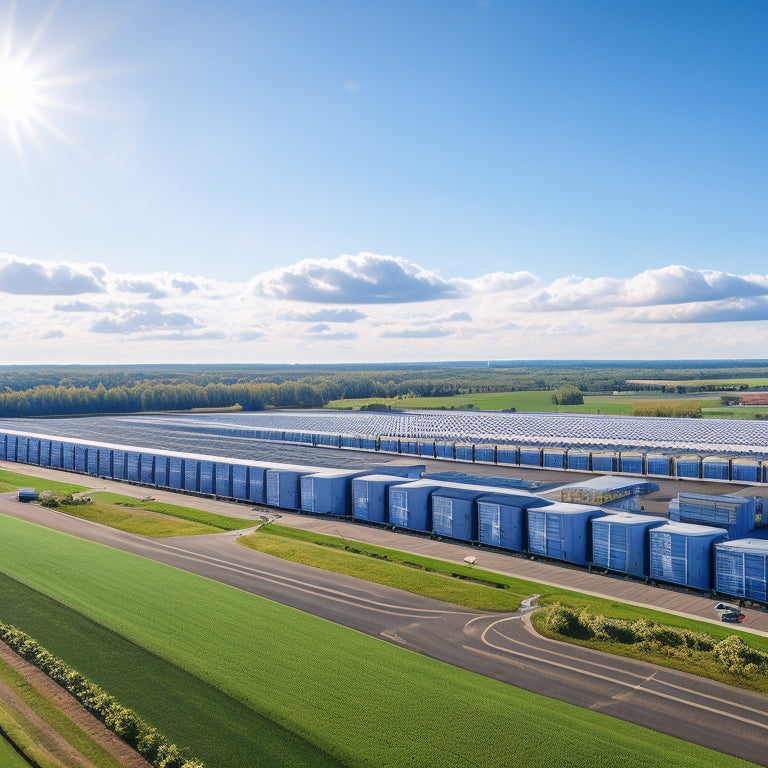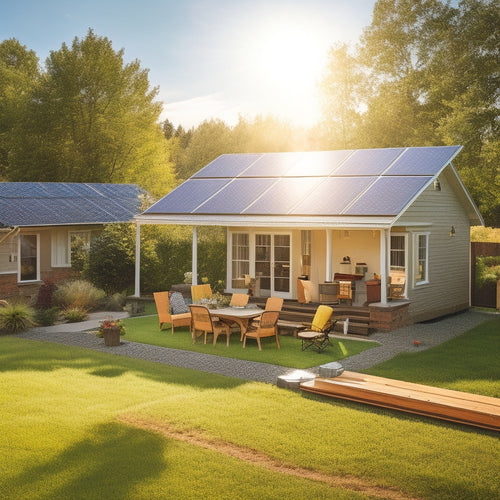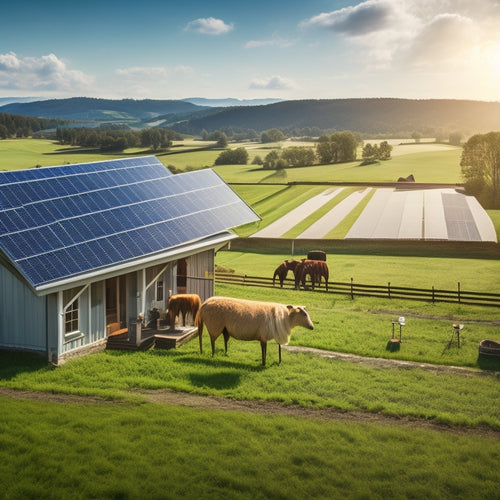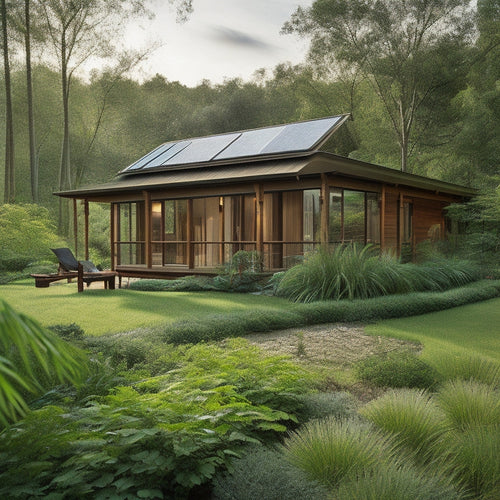
Industrial Solar Solutions for Industrial Parks and Estates
Share
You're looking to power your industrial park or estate with a reliable, cost-effective energy solution. Industrial solar solutions can help you achieve energy independence, reduce operating costs, and support long-term sustainability goals. By utilizing on-site solar power, you can lower your energy bills, create jobs, and improve your brand reputation. With customized financing options and various installation choices, including rooftop and ground-mounted systems, you can personalize a solution that meets your specific energy needs. As you investigate industrial solar solutions, you'll find out how to optimize energy output, minimize implementation challenges, and maximize returns on investment - and that's just the beginning.
Key Takeaways
- Industrial solar solutions provide energy independence, reducing reliance on external power sources and enhancing brand reputation through sustainability initiatives.
- Rooftop installations, ground-mounted systems, and tracking systems are available to meet specific energy needs and optimize energy output.
- Implementing solar solutions can lower energy bills, allowing for reinvestment and improving operational stability by controlling energy costs.
- Solar energy generates electricity without emitting greenhouse gases, supporting climate change mitigation and sustainable development efforts.
- Financing options, tax credits, and incentives are available to support industrial solar projects, maximizing ROI and encouraging adoption.
Benefits of Industrial Solar Power
As industrial operations increasingly prioritize sustainability and cost-effectiveness, the benefits of industrial solar power become more apparent. You can achieve energy independence by generating your own clean energy on-site, reducing reliance on the grid and mitigating price volatility.
Industrial solar power also supports sustainability initiatives, helping you meet environmental targets and enhance your brand reputation. Additionally, solar projects create jobs during installation, operation, and maintenance, stimulating local economies.
Technological advancements have improved system efficiency and reduced costs, making industrial solar power a competitive option. You'll benefit from lower system maintenance requirements and seamless grid integration.
Financing options are also available, allowing you to tailor a solution that suits your business needs. Moreover, industrial solar power cultivates community engagement and regulatory compliance, as you demonstrate commitment to a low-carbon future.
Solar Panel Installation Options
With regards to your industrial solar power project, selecting the best solar panel installation option is crucial. You have several options to evaluate, each with its unique advantages and constraints.
Rooftop installations, for instance, are ideal for industrial buildings with existing infrastructure, while ground-mounted systems are better suited for open spaces or areas with limited roof access.
Tracking systems can optimize energy output by adjusting to the sun's movement, while solar canopies provide additional shading and protection for your equipment or vehicles.
Hybrid systems, which combine solar power with traditional energy sources, can guarantee a stable energy supply.
When choosing an installation option, assess factors such as energy storage, maintenance strategies, system sizing, and financing options.
A thorough site assessment will help determine the most suitable installation option for your industrial park or estate.
Reducing Energy Dependence Costs
You're likely aware that your industrial facility's energy bills are a considerable expense.
By shifting to industrial solar solutions, you can reduce your energy dependence costs in two key ways: through energy bill reduction and on-site power generation.
These benefits can greatly impact your bottom line, and it's worth exploring how they can be achieved.
Energy Bill Reduction
Rising energy costs can be a significant burden for industrial operations, and reducing energy dependence is essential to maintaining profitability.
You're likely no stranger to the impact of fluctuating energy prices on your bottom line. By implementing industrial solar solutions, you can reduce your energy bill and reinvest those savings into your business.
A thorough cost analysis will help you identify areas where energy efficiency improvements can have the greatest impact.
You'll want to assess your current energy usage patterns, identifying opportunities to optimize your energy consumption and reduce waste.
Industrial solar solutions can then be customized to meet your specific energy needs, providing a reliable and sustainable source of power.
On-Site Power Generation
By integrating industrial solar solutions into your operation, you can take control of your energy costs and reduce your dependence on the grid.
On-site power generation allows you to produce the energy you need, when you need it, reducing your reliance on external power sources.
With solar technology advancements, you can utilize the power of the sun to generate electricity, providing a clean and sustainable source of energy.
Environmental Impact of Solar Energy
Two-thirds of the world's greenhouse gas emissions come from energy production, making it a considerable contributor to climate change. You're likely aware that traditional energy sources, such as fossil fuels, are major polluters. In contrast, solar energy offers a cleaner alternative, playing an essential role in the energy shift towards environmental sustainability.
By utilizing solar energy, you can greatly reduce your carbon footprint. This renewable resource generates electricity without emitting greenhouse gases or pollutants, resulting in ecosystem benefits and pollution reduction.
In fact, a single megawatt of solar energy can prevent up to 2,000 tons of carbon dioxide emissions annually. This is imperative, as climate change mitigation efforts require a drastic reduction in emissions.
Embracing solar energy is a key step towards sustainable development. By integrating green technology into your industrial park or estate, you'll not only minimize your environmental impact but also contribute to a cleaner, healthier environment for future generations.
Solar Solution Design Considerations
Facilities seeking to integrate industrial solar solutions must carefully consider several design factors to guarantee ideal performance and efficiency.
You'll need to assess your site's energy requirements through load analysis, identifying opportunities to optimize energy storage and system efficiency. A thorough site assessment will help you determine the best technology integration strategy, ensuring regulatory compliance and grid connectivity.
Design flexibility is vital, as it allows you to adapt to changing energy demands and integrate new technologies as they emerge.
Your design should also prioritize maintenance strategies, ensuring that your system operates at peak performance with minimal downtime.
Performance monitoring is essential, providing real-time observations into system efficiency and identifying areas for improvement.
Overcoming Implementation Challenges
As you progress with your industrial solar solution, you'll inevitably face implementation challenges that can impact project timelines, budgets, and overall success. To overcome these challenges, it's crucial to anticipate and plan for them proactively.
| Challenge | Description | Mitigation Strategy |
|---|---|---|
| Financing Options | Securing funding for your industrial solar solution can be complex and time-consuming. | Investigate government incentives, tax credits, and private financing options to find the best fit for your project. |
| Regulatory Obstacles | Steering through local and national regulations can be overwhelming. | Engage with local authorities and regulatory bodies early on to guarantee compliance and avoid project delays. |
| Stakeholder Engagement | Coordinating with various stakeholders, including investors, contractors, and local communities, can be challenging. | Establish open communication channels and define clear roles and responsibilities to guarantee stakeholder buy-in. |
| Technology Integration | Integrating solar technology with existing infrastructure can be complex. | Partner with experienced technology providers and conduct thorough site assessments to confirm seamless integration. |
| Site Assessment | Conducting thorough site assessments can be time-consuming and costly. | Employ advanced site assessment tools and consult with experienced professionals to identify potential issues early on. |
Maximizing ROI With Solar Incentives
You can greatly enhance your industrial solar project's return on investment by taking advantage of available incentives.
You're likely eligible for tax credit opportunities that can offset a substantial portion of your installation costs.
Additionally, you can benefit from energy savings incentives and grant funding options that further reduce your expenses.
Tax Credit Opportunities
One considerable advantage of investing in industrial solar solutions is the opportunity to capitalize on tax credit opportunities, which can greatly enhance your return on investment (ROI).
By leveraging these incentives, you can greatly reduce your tax liability and increase your cash flow.
Some of the key tax credit opportunities to evaluate include:
-
Investment Tax Credits (ITCs): Claim up to 30% of your solar investment costs as a credit against your tax liability.
-
Depreciation Benefits: Accelerate your depreciation schedule to write off your solar investment more quickly, generating larger tax savings.
-
Research and Development (R&D) Tax Credits: If your solar project involves innovative technologies or processes, you may be eligible for R&D credits.
-
State and Local Incentives: Many states and local governments offer additional tax credits, grants, or rebates for solar investments.
-
Bonus Depreciation: Claim an immediate first-year depreciation deduction of up to 100% of your solar investment costs.
Energy Savings Incentives
Optimism about the financial benefits of industrial solar solutions grows as the spotlight shines on energy savings incentives, an essential aspect of maximizing ROI with solar incentives. You can greatly reduce your energy expenses by leveraging these incentives, which are designed to encourage energy efficiency and reduce your carbon footprint.
| Incentive | Description |
|---|---|
| Net Metering | Allows you to generate your own energy and export excess to the grid, reducing your energy bills |
| Time-of-Use (TOU) Rates | Offers lower electricity rates during off-peak hours, perfect for industrial parks with flexible energy usage |
| Demand Response Programs | Rewards you for reducing energy consumption during peak hours, helping to stabilize the grid |
| Energy Efficiency Rebates | Provides cash incentives for implementing energy-efficient measures, such as upgrading to LED lighting |
| Peak Demand Management | Encourages you to shift non-essential energy usage to off-peak hours, reducing strain on the grid |
Grant Funding Options
As the pursuit of maximizing ROI with solar incentives continues, grant funding options emerge as a vital component in the industrial solar solution environment.
You can utilize these funding sources to offset the upfront costs of your solar project, making it more financially viable. To tap into these opportunities, you'll need to understand the grant eligibility criteria, application process, and funding sources available.
Some key government programs and funding sources to investigate include:
- Sustainability grants from the Department of Energy for large-scale industrial solar projects
- Renewable grants from the Environmental Protection Agency for projects that demonstrate innovative solar technologies
- State-specific grants for industrial solar projects that promote economic development and job creation
- Utility-sponsored grants for industrial customers who invest in on-site solar generation
- Federal tax credits and depreciation benefits for industrial solar projects that meet specific requirements
Frequently Asked Questions
Can Industrial Solar Power Systems Be Connected to the Grid?
You can connect industrial solar power systems to the grid, enabling grid connectivity and increasing energy efficiency. By doing so, you'll optimize your energy output, reduce reliance on traditional power sources, and even sell excess energy back to the grid.
How Does Solar Power Affect Industrial Equipment Performance?
You'll notice that solar power integration can enhance industrial equipment performance by optimizing voltage stability, reducing electrical noise, and increasing motor efficiency, ultimately leading to efficiency improvements and cost savings through reduced energy consumption and extended equipment lifespan.
Are Solar Panels Resistant to Harsh Industrial Environments?
You'll find that solar panels are designed to withstand harsh industrial environments, boasting exceptional durability and adaptability. Their rugged construction guarantees they can operate at peak performance in extreme temperatures, humidity, and exposure to chemicals, making them a reliable choice for your power needs.
Can Industrial Solar Solutions Be Integrated With Energy Storage?
As you take the reins of energy independence, you'll find that integrating energy storage with your solar solution is a transformative factor, unblocking cost savings and a reliable power supply that's always on your side.
Do Industrial Solar Systems Require Frequent Maintenance?
You'll find that solar systems, in general, don't require frequent maintenance, but regular checks can optimize system efficiency; typically, maintenance frequency depends on factors like panel quality, installation quality, and environmental conditions.
Conclusion
As you flip the switch on industrial solar solutions, the writing's on the wall: it's time to utilize the power of the sun to fuel your industrial park or estate's growth. By cutting energy dependence costs and reducing your carbon footprint, you'll be cooking with gas - and reaping the financial benefits that come with it. With careful planning and implementation, the sky's the limit for your solar-powered future.
Related Posts
-

Steps to Prepare for Solar Installation
To prepare for solar installation, start by evaluating your current energy consumption and future needs to determine ...
-

Solar Power Systems for Rural Properties
Solar power systems offer a reliable and efficient energy solution for rural properties, allowing you to gain energy ...
-

Affordable Sustainable Building Materials for Homes
You can build an eco-friendly home on a budget by choosing affordable sustainable materials. Consider using reclaimed...


